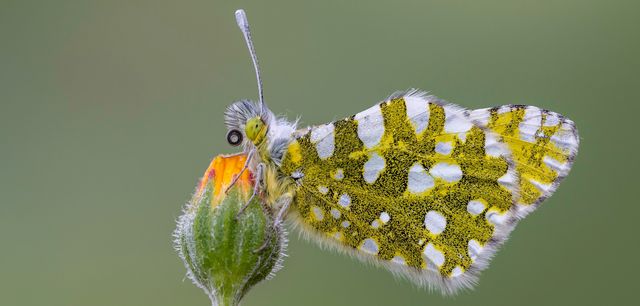02 November 2023
Bears withdraw into their caves, and many birds fly south in good time. But how do insects survive the winter?
Well-travelled migrating butterflies
Butterflies look like fair weather short-distance fliers. And yet, the admiral, for instance, covers several thousand kilometres to get to southern Europe or North Africa every autumn. This butterfly climbs to the very highest altitudes, hitching a ride on the strong winds that blow up there to save itself the effort of having to flap its wings too much. But the distance record among the lepidoptera must go to the painted lady, which leaves Europe to cross the Mediterranean, the mountains of North Africa and the Sahara before finally ending up in the Sahel, some 4,000 kilometres away, where it remains nice and warm throughout the European winter.
Brimstone butterfly – antifreeze in the veins
Other butterfly species can cope with frosty conditions and spend their winters at home too. The brimstone butterfly uses its own natural antifreeze: this consists mainly of glycerine. The butterfly uses this sugar alcohol to lower the freezing point of its bodily fluids, also known as the haemolymph. As soon as it gets cold, it expels as much water as possible, retaining only that which is absolutely necessary. This is because the lower the water volume in the body, the longer it takes for the ice to crystallise. In this way, the butterfly makes sure that the haemolymph in its veins doesn’t freeze even in temperatures as low as minus 20 degrees. And they need to be this tough to get through the winter. While peacock butterflies and small tortoiseshells seek refuge in caves, cellars or attics, brimstone butterflies tough it out outside: They nestle down in crevices in tree bark or on the undersides of blackberry leaves and remain stubbornly dormant even when covered with an unwanted coating of snow.
Honeybees – all for one
A queen bee will live for up to five years. And the responsibility for keeping her alive over the winter months rests with what are known as winter bees. Unlike summer bees, they don’t depart this life after a mere six weeks; instead, they live up for up to seven months. Because they live for so long, there’s no need to call on a new brood of bees in the winter. This saves both energy and resources. Finally, this makes it perfectly possible to keep the whole buzzing colony alive with a very small team of females.
The bees team up to protect their precious queen from the cold. They form a cluster around their sovereign lady and keep her warm by contracting their muscles. At the heart of the cluster around the queen, the temperature can rise to 30 degrees – ideal T-shirt weather. To ensure that the workers don’t get too cold, the bees work according to the rotation principle: they regularly change positions within the cluster and migrate from the outside to the inside.
Bumblebees – lone fliers
Unlike honeybees, bumblebees are solo fliers. And yet, these furry hymenoptera don’t live alone, although bumblebee colonies number no more than 600 instead of 10,000 individuals. And unlike the honeybees, bumblebees die in the autumn. All bar one, that is: After mating in August, the juvenile queen finds a molehill or compost heap or simply digs her way into the soil. Once ensconced, she goes into hibernation and relies on the fat stores that she has previously accumulated to keep herself alive. She is protected from the cold by her fuzzy hairs and the glycerine in her body that works like antifreeze. This winter survival kit allows bumblebees in colder regions to live longer than honeybees and even to make their home in the Arctic. Their own natural heating system is one of the things that makes this possible. Bumblebees reach their operating temperature by vibrating their chest muscles, thus shaking themselves warm. Once she awakens from her hibernation, the queen is therefore able to seek out snowdrops and other early flowers at temperatures as low as two degrees.
Ants – going underground
In tropical regions, ants are active all year round. In colder climes, they retreat to the interior of their nest in early October – burrowing down two metres below ground. These industrious insects first make sure their anthill is protected from snow and rain. Just like the brimstone butterfly, they produce glycerine and expel all surplus water. They then power down their metabolism and go into hibernation. When March arrives, it’s time for the new season to start. The first to emerge are the workers, who climb up to the top of the outside of the nest to bask in the sunshine. They then go back into the structure, where they act as crawling radiators to warm up their fellows.
Ladybirds – Snow White with spots
Some ladybirds make their way to more southerly climes in the autumn. Others seek out winter quarters up here in the north: piles of leaves are particularly popular, as are cracks in walls and attics. Here they will form groups of up to 100 individuals. Before hibernation, they empty their guts to give the cold fewer vulnerabilities to exploit. Like ants, bumblebees and brimstone butterflies, they also produce glycerine, which allows them to survive even icy temperatures. In cities, incidentally, ladybirds enjoy spending the winter between inner and outer windows or on window sills. So, if you should find what looks like a dead ladybird here, don’t dispose of it or bury it! The talismanic little insect is just asleep and will be raring to go hunting for aphids come the spring.



